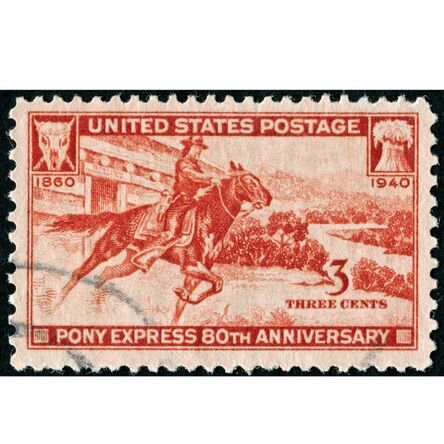 Horses have been apart of some of the most important and iconic events and moments in history. In this blog, we are going to be talking about the history of the Pony Express. Hello, everyone! We hope you've stumbled upon our blog to learn more about the best horseback riding trails in South Carolina! This weather is so perfect to be on our trials. As the weather slowly starts to turn you'll see even more beauty that the Lowcountry has to offer. Make sure to book your historic trail rides today, we can't wait to see you! We've gotten to thinking through all the historic research we've been doing for our recent blogs, and we realized that horses have been apart of some of the most important and iconic moments in the early history of the United States. Up until the early 1900s when Henry Ford made the car affordable and accessible to almost every American, the horse was right there getting us to and from everyday tasks and events, some that would forever change our everyday lives as a country. One of the most iconic events lasted a very short amount of time but has remained in history's spotlight, in our textbooks, and in our hearts ever since it ended. Today, we are going to be talking about the history of the Pony Express. The Pony Express only lasted for two years and made less than 400 runs, but it is still one of the most iconic parts of our history. Its story has lasted because of the endurance and bravery of its riders and its connection to famous people like Mark Twain and Buffalo Bill Cody. Cody was one of the Express's most famous promoters, but he never actually rode for them! He was much more of a showman. The Pony Express was born when our country was under huge changes both politically and personally. Imagine America right after the gold rush, right as Abraham Lincoln became president, and when the country was right on the brink of civil war. It was born when information needed to be delivered as quickly as possible, but a mode of transportation was not yet available. The Pony Express changed all of this. The Pony Express riders helped deliver news faster than ever before all thanks to the powerful horses that these brave riders rode. They cut down the time to carrying news from what could be a couple of months down to a few days. They did this by adding more relay stations and making use of the telegraph, according to National Geographic. Individuals could now stay in touch with their loved ones, no matter where they lived. It wasn't just private individuals that were benefiting from this new form of news delivery, newspapers and magazines relied on getting their information from the Express, too. For a total of eighteen months, the Pony Express delivered the mail faster than ever before between April 1860 and October of 1861. It helped tie the east to the west carrying some of the most important news of the time. Young men would ride what would later become the Pony Express National Historic Trail, covering eight states. It was the most direct form of communication of its time between Missouri to California. They could ride up to 1800 miles in just ten days. Millions began the move out west in the mid-1840s because of the gold rush and the Mormon exodus, according to The National Pony Express. With so many people on the other side of the country, a new form of communication was needed. In came William H. Russell, Alexander Majors, and William B. Waddell. They created The Central Overland California and Pikes Peak Express Company to deliver mail from one end of the country to the other. This would later become the Pony Express. According to the National Pony Express, shortly after the Express was created, congress authorized a bill to build a telegraph line that would run from the Missouri River to the Pacific Coast. While the line was under construction, the Pony Express delivered its letters, news, and newspapers. When the telegraph line was finally finished in 1861, the Pony Express shut down. Its last letters were delivered in November of that year. Even with its short history, it has become embedded into the history of the Wild West thanks to Wild West shows that traveled across the country and even into Europe. Ironically, these shows and the stars that made them famous (like Buffalo Bill Cody) were famous much after the Pony Express ended. It still raised public awareness about the Express and kept it alive in history. Even though it has been kept alive, a lot of the history is full of inaccuracies, wild stories, and myths according to National Geographic. Almost no records survive of this famous 18 month period. The young men who were riders for the Express would ride up to 100 miles a day and sometimes up to four times a week. They all had to follow some very strict rules like no drinking or cursing, according to National Geographic. They were facing every kind of challenge nature could put in front of them and in some of the most dangerous parts of the country. Through snowy mountain passes and dangerous deserts, they made their rides. They came into contact with Native Americans and wild animals, and all kinds of other perils. Some Pony Express riders were killed and some stations were burned down after relations between Native Americans and Americans were heated. Service even stopped in certain areas because of it, but after the stations were rebuilt, service went back to normal. Today, it continues to live on in colorful stories, reenactments, and historical locations that you can visit. Most of the original trail doesn't exist any more thanks to modern roads, construction, and time. What is believed to be left of the original trail can be seen in Utah and California. According to the National Pony Express, some 120 historic sites might soon be available to the public. What do you remember learning about the Pony Express? Have you ever visited any of its historic locations? It's incredible how much history horses helped shape and carry thanks to each ride those young men went on. Imagine how different our world would be without them! Until next time, stay safe and stay hopeful everyone!
0 Comments
Leave a Reply. |
AuthorMiddleton Place Team Archives
January 2021
Categories
All
|
|
4280 Ashley River Road, Charleston, SC 29414
[email protected] 843-735-0709 Please also visit: Middleton Place | The Inn at Middleton Place |
Site powered by MadeSimply
|
 RSS Feed
RSS Feed

